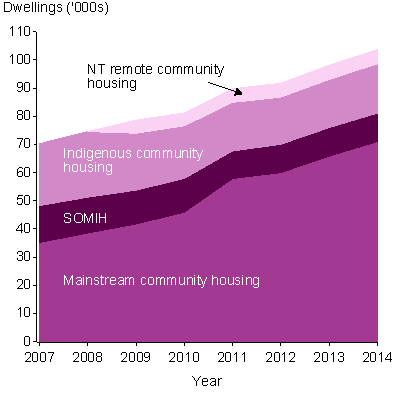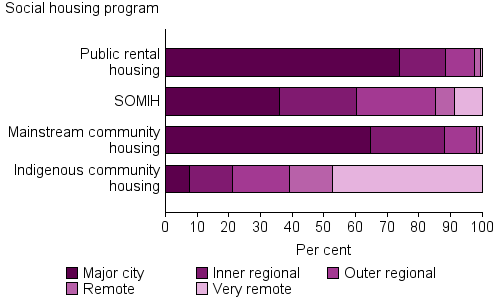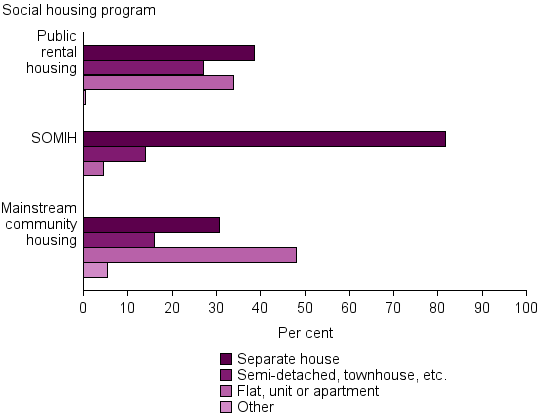Social housing dwellings
Social housing is rental housing that government or non-government organisations (including not-for-profit organisations) provide to assist people who are unable to access affordable and sustainable housing options. Social housing aims to deliver appropriate, flexible and diverse housing, targeted to assist low income and disadvantaged households. There are four social housing programs in Australia:
- public rental housing,
- mainstream community housing,
- state owned and managed Indigenous housing (SOMIH), and
- Indigenous community housing.
More information about social housing programs
How many dwellings?
As at 30 June 2014, there were 427,600 social housing dwellings—an increase from 412,400 dwellings in 2007–08. However, the distribution of dwellings across social housing programs has changed over time.
There has been a gradual but steady policy focus towards growing the community housing sector and transferring ownership or management of public rental housing stock to community housing organisations. This is a result of the rising cost of social housing programs that are managed and run by state housing authorities.
Between 2007–08 and 2013–14, public rental housing stock reduced by approximately 5% (337,900 to 323,800), and mainstream community housing increased by 46%, from 38,500 to 71,000 dwellings (Figure 1).
Figure 1: Number of social housing dwellings by program type, 2007–2014

Note: ‘Other social housing’ includes mainstream community housing, SOMIH, Indigenous community housing and NT remote community housing.
Source: AIHW National Housing Assistance Data Repository 2013–14. Source data
SOMIH stock reduced between 2007–08 and 2013–14 from 12,800 to 10,100 dwellings. Indigenous community housing dwelling numbers also decreased from 23,300 to 17,500 over the same period (Figure 2).
Figure 2: Number of social housing dwellings by program type (excluding public rental housing), 2007–2014

Source: AIHW National Housing Assistance Data Repository 2013–14. Source data
As at 30 June 2014, the overall occupancy rate for public housing dwellings was 98%, with a high of 99% in the Australian Capital Territory and a low of 93% in the Northern Territory. Overall SOMIH dwelling occupancy rates were 97%, and community housing dwellings 94%. The overall occupancy rate for Indigenous community housing dwellings was 95%.
Location
As at 30 June 2014, New South Wales had the largest number of social housing dwellings across each program type, except for Indigenous community housing, which had more dwellings reported in Queensland. Victoria had the next highest number of dwellings for public housing and community housing.
| Social housing program | NSW | Vic | Qld | WA | SA | Tas | ACT | NT | Aust |
|---|---|---|---|---|---|---|---|---|---|
| Public housing | 110,805 | 64,471 | 51,368 | 33,467 | 39,422 | 8,413 | 10,848 | 5,009 | 323,803 |
| SOMIH(a) | 4,632 | . . | 3,383 | . . | 1,815 | 283 | . . | . . | 10,113 |
| Mainstream community housing | 26,425 | 14,268 | 11,667 | 6,967 | 5,974 | 4,787 | 610 | 338 | 71,036 |
| Indigenous community housing(b) | 4,730 | 1,966 | 5,013 | 2,493 | 1,102 | 73 | . . | 2,152 | 17,529 |
| All programs | 146,592 | 80,705 | 71,431 | 42,927 | 48,313 | 13,556 | 11,458 | 7,499(c) | 422,481(c) |
- Victoria, Western Australia, the Australian Capital Territory and the Northern Territory do not have SOMIH programs.
- NSW Indigenous community housing data includes funded and unfunded dwellings. Vic, Qld, WA, SA, Tas and NT Indigenous community housing data relates to funded dwellings only.
- The figures for Australia and NT do not include remote community housing dwellings in the Northern Territory (5,096). Remote community housing dwelling counts are provided separately, as they are not currently captured by the ICH or public rental housing data collections. These dwellings are not included in any analysis as no details are known.
Source: AIHW National Housing Assistance Data Repository 2013–14.
Proportions of social housing dwellings varied across remoteness areas. Public rental housing and mainstream community housing represented the highest proportion of social housing in Major cities, SOMIH in Outer regional areas, and Indigenous community housing in Remote and Very remote areas (Figure 3).
As at 30 June 2014, most public rental housing dwellings were located in Major cities (74%), followed by Inner regional areas (15%). Less than 1% of public rental housing was located in Very remote areas. The majority of SOMIH dwellings were also located in Major cities (36%), followed by Outer regional (25%) and Inner regional areas (24%).
Mainstream community housing followed a similar trend, with 65% of dwellings located in Major cities. Less than 1% of mainstream community housing were located in Very remote areas. As expected, a large proportion (61%) of Indigenous community housing was located in Remote or Very remote areas.
Figure 3: Proportion of social housing dwellings by remoteness area and housing program type, 2014 (per cent)

Source: AIHW National Housing Assistance Data Repository 2013–14. Source data
Dwelling type
As at 30 June 2014, public rental housing dwellings were more likely to be in the form of a separate house (39%), followed by a flat, unit or apartment (33%).
The vast majority of SOMIH dwellings were in the form of a separate house (82%), whereas mainstream community housing dwellings were more likely to be a flat, unit or apartment (48%) (Figure 4).
Figure 4: Proportion of social housing dwellings by dwelling type and housing program type, 2014 (per cent)

Source: AIHW National Housing Assistance Data Repository 2013–14. Source data
Dwelling size
The size of social housing dwellings in 2014 differed across program type. Public rental housing dwellings reported a greater proportion of three bedroom dwellings (38%), followed by two bedroom dwellings (30%). SOMIH dwellings also reported a greater proportion of three bedroom dwellings (62%).
Mainstream community housing dwellings reported a greater proportion of one and two bedroom dwellings (33% and 35%, respectively). Indigenous community housing reported a greater proportion of three bedroom dwellings (50%) (Figure 5).
Figure 5: Proportion of social housing dwellings by household size and housing program type, 2014 (per cent)

Source: AIHW National Housing Assistance Data Repository 2013–14. Source data
Dwelling standard
As at 30 June 2014, most social housing dwellings were reported to be of an acceptable standard, with at least four working facilities and not more than two major structural problems.
Of social housing dwellings:
- 70% of SOMIH dwellings were of an acceptable standard
- 81% of public housing dwellings were of an acceptable standard
- 89% of mainstream community housing dwellings were of an acceptable standard.
Data on dwelling standard on Indigenous Community Housing are not available.
Indigenous households within public rental housing were less likely to report living in a dwelling of an acceptable standard (66%), compared with 70% of SOMIH dwellings and 83% of mainstream community housing dwellings. Furthermore, households with at least one member with a disability were less likely to live in a dwelling of an acceptable standard within public rental housing, SOMIH and community housing dwellings (75%, 64%, and 85%, respectively).


